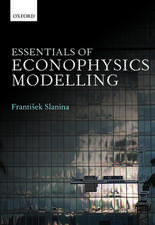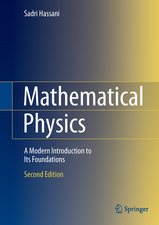The General Theory of Homogenization: A Personalized Introduction: Lecture Notes of the Unione Matematica Italiana, cartea 7
Autor Luc Tartaren Limba Engleză Paperback – 21 dec 2009
For a better understanding of 20th century science, new mathematical tools must be introduced, like the author’s H-measures, variants by Patrick Gérard, and others yet to be discovered.
Din seria Lecture Notes of the Unione Matematica Italiana
-
 Preț: 432.24 lei
Preț: 432.24 lei -
 Preț: 281.43 lei
Preț: 281.43 lei -
 Preț: 353.79 lei
Preț: 353.79 lei -
 Preț: 418.78 lei
Preț: 418.78 lei -
 Preț: 247.82 lei
Preț: 247.82 lei -
 Preț: 346.59 lei
Preț: 346.59 lei -
 Preț: 389.70 lei
Preț: 389.70 lei -
 Preț: 356.08 lei
Preț: 356.08 lei - 15%
 Preț: 704.36 lei
Preț: 704.36 lei -
 Preț: 347.04 lei
Preț: 347.04 lei - 15%
 Preț: 525.66 lei
Preț: 525.66 lei -
 Preț: 512.27 lei
Preț: 512.27 lei -
 Preț: 390.25 lei
Preț: 390.25 lei -
 Preț: 480.62 lei
Preț: 480.62 lei - 15%
 Preț: 468.90 lei
Preț: 468.90 lei -
 Preț: 416.54 lei
Preț: 416.54 lei -
 Preț: 344.36 lei
Preț: 344.36 lei -
 Preț: 353.99 lei
Preț: 353.99 lei -
 Preț: 448.21 lei
Preț: 448.21 lei - 15%
 Preț: 584.58 lei
Preț: 584.58 lei - 15%
 Preț: 493.89 lei
Preț: 493.89 lei - 15%
 Preț: 582.95 lei
Preț: 582.95 lei -
 Preț: 350.04 lei
Preț: 350.04 lei -
 Preț: 346.97 lei
Preț: 346.97 lei -
 Preț: 390.63 lei
Preț: 390.63 lei -
 Preț: 348.35 lei
Preț: 348.35 lei -
 Preț: 344.47 lei
Preț: 344.47 lei
Preț: 650.19 lei
Preț vechi: 764.93 lei
-15% Nou
Puncte Express: 975
Preț estimativ în valută:
124.43€ • 129.43$ • 102.72£
124.43€ • 129.43$ • 102.72£
Carte tipărită la comandă
Livrare economică 14-28 aprilie
Preluare comenzi: 021 569.72.76
Specificații
ISBN-13: 9783642051944
ISBN-10: 3642051944
Pagini: 496
Ilustrații: XXII, 471 p.
Dimensiuni: 155 x 235 x 25 mm
Greutate: 0.69 kg
Ediția:2010
Editura: Springer Berlin, Heidelberg
Colecția Springer
Seria Lecture Notes of the Unione Matematica Italiana
Locul publicării:Berlin, Heidelberg, Germany
ISBN-10: 3642051944
Pagini: 496
Ilustrații: XXII, 471 p.
Dimensiuni: 155 x 235 x 25 mm
Greutate: 0.69 kg
Ediția:2010
Editura: Springer Berlin, Heidelberg
Colecția Springer
Seria Lecture Notes of the Unione Matematica Italiana
Locul publicării:Berlin, Heidelberg, Germany
Public țintă
ResearchCuprins
Why Do I Write?.- A Personalized Overview of Homogenization I.- A Personalized Overview of Homogenization II.- An Academic Question of Jacques-Louis Lions.- A Useful Generalization by Fran#x00E7;ois Murat.- Homogenization of an Elliptic Equation.- The Div#x2013;Curl Lemma.- Physical Implications of Homogenization.- A Framework with Differential Forms.- Properties of H-Convergence.- Homogenization of Monotone Operators.- Homogenization of Laminated Materials.- Correctors in Linear Homogenization.- Correctors in Nonlinear Homogenization.- Holes with Dirichlet Conditions.- Holes with Neumann Conditions.- Compensated Compactness.- A Lemma for Studying Boundary Layers.- A Model in Hydrodynamics.- Problems in Dimension = 2.- Bounds on Effective Coefficients.- Functions Attached to Geometries.- Memory Effects.- Other Nonlocal Effects.- The Hashin#x2013;Shtrikman Construction.- Confocal Ellipsoids and Spheres.- Laminations Again, and Again.- Wave Front Sets, H-Measures.- Small-Amplitude Homogenization.- H-Measures and Bounds on Effective Coefficients.- H-Measures and Propagation Effects.- Variants of H-Measures.- Relations Between Young Measures and H-Measures.- Conclusion.- Biographical Information.- Abbreviations and Mathematical Notation.
Recenzii
From the reviews:
“The book is divided in 34 short chapters including the introduction and a conclusion. … Each chapter ends with some historical details on the mathematical authors who have been cited in the chapter. The book is surely interesting both from the mathematical point of view … and for the historical background on homogenization theory, including H-convergence and Young measures. … many mathematicians will learn how to use the key tools and to develop the basic but deep tools which can be used within this context.” (Alain Brillard, Zentralblatt MATH, Vol. 1188, 2010)
“In his book Luc Tartar ‘re-animates’ the historical genesis of one of the most important ideas in mathematical analysis of the last century, leading to a general theory of homogenization … . a treasure trove for all those working in the field and those who want to get acquainted with it. … it encourages young researchers to build on the material offered and develop new ideas. … he or she will appreciate the author’s effort to give a ‘full’ and perhaps necessarily personalized picture.” (Guenter Leugering, Mathematical Reviews, Issue 2011 c)
“The book is divided in 34 short chapters including the introduction and a conclusion. … Each chapter ends with some historical details on the mathematical authors who have been cited in the chapter. The book is surely interesting both from the mathematical point of view … and for the historical background on homogenization theory, including H-convergence and Young measures. … many mathematicians will learn how to use the key tools and to develop the basic but deep tools which can be used within this context.” (Alain Brillard, Zentralblatt MATH, Vol. 1188, 2010)
“In his book Luc Tartar ‘re-animates’ the historical genesis of one of the most important ideas in mathematical analysis of the last century, leading to a general theory of homogenization … . a treasure trove for all those working in the field and those who want to get acquainted with it. … it encourages young researchers to build on the material offered and develop new ideas. … he or she will appreciate the author’s effort to give a ‘full’ and perhaps necessarily personalized picture.” (Guenter Leugering, Mathematical Reviews, Issue 2011 c)
Textul de pe ultima copertă
Homogenization is not about periodicity, or Gamma-convergence, but about understanding which effective equations to use at macroscopic level, knowing which partial differential equations govern mesoscopic levels, without using probabilities (which destroy physical reality); instead, one uses various topologies of weak type, the G-convergence of Sergio Spagnolo, the H-convergence of François Murat and the author, and some responsible for the appearance of nonlocal effects, which many theories in continuum mechanics or physics guessed wrongly.
For a better understanding of 20th century science, new mathematical tools must be introduced, like the author’s H-measures, variants by Patrick Gérard, and others yet to be discovered.
For a better understanding of 20th century science, new mathematical tools must be introduced, like the author’s H-measures, variants by Patrick Gérard, and others yet to be discovered.
Caracteristici
Includes supplementary material: sn.pub/extras
















